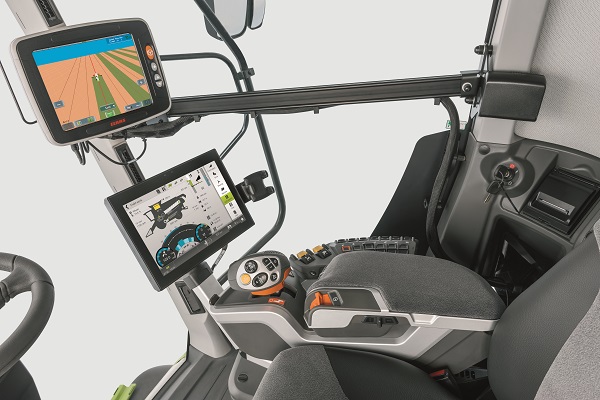As combines continue to roll out across the country, it marks an appt time for growers to think about the condition of their existing kit and whether it’s time to invest in something new. While the original Claas Lexion has been a long-standing favourite with many farmers, the launch of the second-generation Lexion Hybrid adds another option to consider. CPM takes a look at Claas’ latest offering which promises power, performance and profitability.
By Charlotte Cunningham
Originally launched in 1995, it’s fair to say that the Claas Lexion changed the way that arable crops were harvested, setting the benchmark for cost efficient, high output harvesting and cementing a place in growers hearts as a much-loved piece of kit.
Now, some 24 years later, Claas has announced the introduction of the second-generation of Lexion Hybrid combine harvesters.

After 10 years and over 6,000 hours of endurance testing the new Lexion Aps Synflow Hybrid range has been completely redesigned to enable growers to handle all crops in a range of conditions. While the essence of the original Lexion is still intact, about 66% of the parts are actually completely different from the outgoing model – which currently accounts for around 75% of all hybrid and rotary combines sold in the UK.
So what exactly sets it apart from both the previous model and anything else on the market?
Power
Two versions of the new model are available – the wide body Lexion 8000, which comprises three variants and a further five models in the narrow body Lexion 7000 range.
The most significant of these is probably the wide body 89000 which at 790hp looks to be the Buggatti Veyron of the arable world, after officially claiming the title as the most powerful combine on the market.
For optimum fuel efficiency and economy all models are fitted with the Dynamic Power intelligent engine management system which automatically adjusts engine power output relative to load. Dynamic Cooling variable fan cooling is also standard on all models, which draws clean air in from above the combine and blows it out down over the sides of the machine.
The new drive system, based on Jaguar forage harvester, has been included to promote a more positive, smooth engagement of the threshing and auger systems while an improved clutch system has been installed to engage and tension the belts, resulting in improved belt life.
Threshing system
At the heart of the new launch is the APS threshing system which has been developed to increase harvesting capacity.
The new 755mm diameter threshing drum is an impressive 26% larger than the current 600mm drum found on the Lexion 780, and is fitted with 10 rasp bars, compared to eight. These significant tweaks mean that the new-look Lexion can thresh out 70% of the grain, leaving just 30% to be removed by the Roto Plus secondary separation system.
A larger feed drum means an improved flow of material into this secondary separation system, while the angle of the rotors themselves has been flattened for higher throughput and reduced straw damage.
To reflect the higher throughput, grain tank capacity has been increased up to 18,000l on the Lexion 8900. Tank access has been improved and maximum tank unloading speed is now 180l/second with an unloading time of just 100 seconds.
As well as this, the pivot angle of the unloading auger has been changed to 105 degrees, making it easier to see from the cab.
Precision
Unlike the volumetric yield measuring system used in the current Lexion, the new Quantimeter yield measuring system fitted takes its information from a pressure cell. Not only is this a more accurate and robust data collection method, but it only needs to be calibrated once a year for each crop type. It is also fully compatible with Telematics for accurate record keeping and yield mapping.
The latest additions to Claas’ fleet also features the newly developed Field Scanner automatic steering system. Drawing on German influence, this uses a radar scanner which was originally developed by Audi and is mounted on the top of the cab.
Unlike the original Laserpilot steering system which can only scan in one direction, Field Scanner has the ability to scan over an arc of 145 degrees to both the left and the right, and is capable of recognising both standing crops higher than 10cm and tramlines. It also requires no calibration, is easy to set-up and because it can follow tramlines, is suitable for use within a reduced traffic system.
Operator comfort
While all the shiny bells and whistles no doubt make the new Lexion an attractive choice, operator comfort is also a key consideration.
To ensure this, Claas have increased cab size as well as adding sound proofing and a new grain tank window into the design of the latest range.
All the main functions are controlled using the CMotion control – incorporating new favourites management system – as well as the Cebis touchscreen terminal, which can be adjusted independent of the armrest or even swung out of the way for improved visibility. Where Cemos Automatic is specified this information is now fully integrated into the Cebis terminal.
“The original Lexion has built such as reputation for itself, that we knew a second generation had to be bigger and better for growers to be won over,” explains Adam Hayward, Claas UK. “With an increased engine size, greater capacity and improved driver comfort, we believe we’ve made some really significant improvements to a much-loved favourite which should help growers boost performance, productivity and hopefully, profitability.”
For more information visit: https://www.claas.co.uk/products/combines/lexion8000




